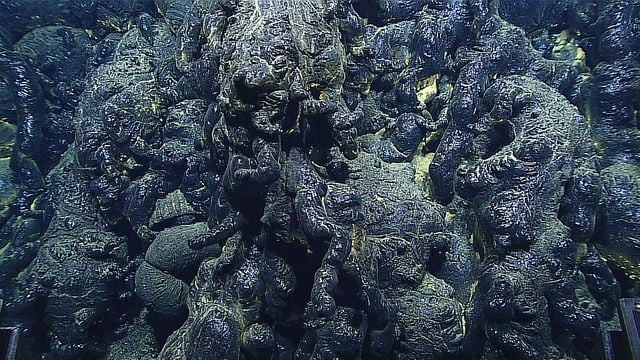Researchers Unearth Glass Labyrinth Created by Underwater Volcanic Eruption
The unusual formation is situated nearly three miles below the ocean’s surface—a distance greater than Mount Rainier’s height above sea level
:focal(996x365:997x366)/https://tf-cmsv2-smithsonianmag-media.s3.amazonaws.com/filer/e8/8a/e88a45bf-a0b9-4260-ab28-5002daa62f6f/voroz2onsaff1njbdnbj.jpg)
Sometime between 2013 and 2015, an underwater volcano located in the western Pacific’s Mariana Trench back-arc erupted, spewing forth a torrent of molten lava. As the sprawling tendrils hit the chilly seawater, they abruptly started cooling. The result: a nearly three-mile deep, labyrinthine network of glassy black lava that stretches roughly 4.5 miles across the ocean floor.
Researchers chanced upon this ethereal glass palace during a routine dive in December 2015, Robin George Andrews writes for The New York Times. The team had originally hoped to use robotic submersibles to uncover hidden hydrothermal vents, but the volcanic deposits proved to be a far more interesting find.
The lava labyrinth, which is newly documented in Frontiers in Earth Science, sits about 2.8 miles below the ocean’s surface. According to Eleanor Imster of EarthSky, this distance is greater than Mount Rainier’s height above sea level, officially making the eruption that produced the unusual phenomenon the world’s deepest.
Earther’s Maddie Stone reports that the scientists, led by Oregon State University marine geologist Bill Chadwick, initially noticed the surface of the structure was sediment-free and venting a milky hydrothermal fluid, suggesting the still-cooling lava was fresh. A second survey conducted in 2016 enabled the team to further pinpoint the timing of the eruption: As the study states, the lava flows exhibited a “rapidly declining hydrothermal system” that pointed toward the eruption occurring just months before the December 2015 expedition.

The new discovery is unique for several reasons: Rebecca Williams, a volcanologist at the University of Hull who wasn’t involved in the study, tells the Times’ Andrews that much of scientists’ current knowledge of underwater eruptions comes from studying old, perhaps even ancient, volcanoes.
Comparatively, the network found lurking in the little-explored depths of the Mariana is relatively youthful, enabling scientists to gain previously unprecedented insights on both the sea-based lava’s chemical alchemy and its burgeoning biological communities. As Brandon Specktor notes for Live Science, the team spotted mobile creatures including shrimp and lobsters colonizing the sprawling formation during return visits. Sessile species such as worms had yet to begin moving in.
Earther’s Stone further writes that researchers have only ever identified evidence of about 40 eruptions at depths below 1,640 feet. Prior to 1990, none had been found, likely due to a lack of sufficient technology.
“We know that most of the world’s volcanic activity actually takes place in the ocean, but most of it goes undetected and unseen,” Chadwick explained in a statement. “That is because undersea quakes associated with volcanism are usually small, and most of the instrumentation is far away on land.”
Still, increasingly advanced monitoring systems may soon point scientists toward similar gardens of glass. In fact, Chadwick says, the Axial Seamount, a volcano located off of the United States’ Pacific Northwest coast, has erupted three times in the last 20 years and is due for another eruption within the next several years.
He added, “Undersea volcanoes can help inform us about how terrestrial volcanoes work and how they impact ocean chemistry, which can significantly affect local ecosystems. It’s a special learning opportunity when we’re able to find them.”
/https://tf-cmsv2-smithsonianmag-media.s3.amazonaws.com/accounts/headshot/mellon.png)
/https://tf-cmsv2-smithsonianmag-media.s3.amazonaws.com/accounts/headshot/mellon.png)